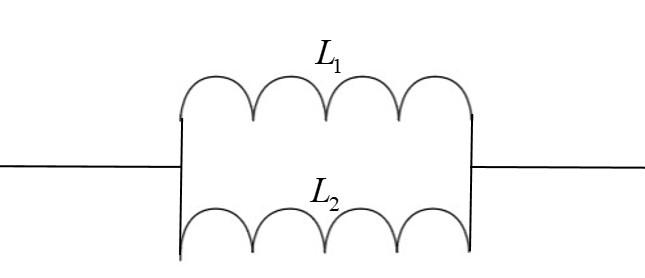
The equivalent inductance of two inductors is 2.4H when connected in parallel 10H when connected in series. The difference between two inductances is (Neglecting mutual inductance):
A. 2H
B. 3H
C. 4H
D. 5H
Answer
498.9k+ views
Hint: Inductance coil is an electrical element of a circuit which stores the electrical energy in the form of magnetic field. Like resistance and capacitor, inductance is also a passive element because it delivers the energy but not on a continuous basis. Inductors are attached in the circuit in series and parallel to each other.
Formula used: In series:

In parallel:

Complete step by step answer:
Let the inductance of the first inductor be
Hence,
And in parallel,
Or
Or
Now, from ①, we have
Or
Or
Or
Now, as
Hence,
Thus,
Hence we can see that the difference between the two inductor values is 2H.
So, the correct answer is “Option A”.
Note: In the question, we are directed to neglect the mutual inductance but practically, we have the mutual inductances between the coils especially if the distances between the inductors is less. Hence if not given to neglect, we have to consider the mutual inductance too. One must be aware that inductors and resistors are similar in the fact that in series, both resistors and inductors are added algebraically to get net value to resistance or inductance and for parallel combination, the reciprocal sum will give the reciprocal of total resistance and inductance of the system.
Formula used: In series:

In parallel:

Complete step by step answer:
Let the inductance of the first inductor be
Hence,
And in parallel,
Or
Or
Now, from ①, we have
Or
Or
Or
Now, as
Hence,
Thus,
Hence we can see that the difference between the two inductor values is 2H.
So, the correct answer is “Option A”.
Note: In the question, we are directed to neglect the mutual inductance but practically, we have the mutual inductances between the coils especially if the distances between the inductors is less. Hence if not given to neglect, we have to consider the mutual inductance too. One must be aware that inductors and resistors are similar in the fact that in series, both resistors and inductors are added algebraically to get net value to resistance or inductance and for parallel combination, the reciprocal sum will give the reciprocal of total resistance and inductance of the system.
Recently Updated Pages
Master Class 9 General Knowledge: Engaging Questions & Answers for Success

Master Class 9 English: Engaging Questions & Answers for Success

Master Class 9 Science: Engaging Questions & Answers for Success

Master Class 9 Social Science: Engaging Questions & Answers for Success

Master Class 9 Maths: Engaging Questions & Answers for Success

Class 9 Question and Answer - Your Ultimate Solutions Guide

Trending doubts
Give 10 examples of unisexual and bisexual flowers

Draw a labelled sketch of the human eye class 12 physics CBSE

Differentiate between homogeneous and heterogeneous class 12 chemistry CBSE

Differentiate between insitu conservation and exsitu class 12 biology CBSE

What are the major means of transport Explain each class 12 social science CBSE

Why is the cell called the structural and functional class 12 biology CBSE




